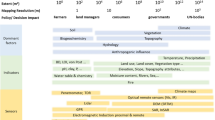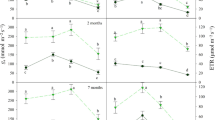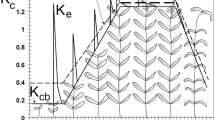Abstract
Background and Aims
The study of environmental factors affecting forest phenology has attracted attention, and we have proposed that moisture and precipitation in the rainy season have an influence on the growth of Populus tomentosa.
Methods
Near-earth remote sensing devices were applied to monitor the canopy phenology of planted Populus tomentosa B301 cultivated under full drip irrigation (DIFI), controlled drip irrigation (DICI), and non-irrigation (CK). The relative green vegetation index was calculated and the TIMESAT3.3 procedure was used to fit the time series curve of the phenological index of Populus tomentosa B301 and the key period of phenological growth was extracted.
Results
The data on the relative green vegetation index and the forest growth change rate are different. The tree species under controlled drip irrigation reached their growth peak on Day 111, 1 d after those with full drip irrigation and non-irrigation. 2) The tree species in the CK area withered and fell on Day 307, those in the DIFI region began to wither and decline on Day 315, and those in the DICI area began to wilt and decline on Day 291. The CK, DIFI, and DICI growing seasons were 222, 230, and 206 d, respectively. 3) Forests have different responses to different irrigation conditions. The use of different irrigation conditions changes the growth and development of the forests, resulting in significant phenological effects.
Conclusion
Appropriate irrigation techniques can improve water resource use efficiency, water environmental factors, and irrigation methods, all of which affect forest growth.








Similar content being viewed by others
Data availability
All data will be available on request.
References
Bhunia R, Verma IM, Sahu MP et al (2015) Effect of drip irrigation and bioregulators on yield, economics and water use of fenugreek (Trigonella foenum-graecum). J Spices Aromat Crops 24(2):102–105
Brum M, Oliveira R, Lopez J et al (2021) Effects of irrigation on oil palm transpiration during ENSO-induced drought in the Brazilian Eastern Amazon. Agric Water Manag 245:106569
Chao Z, Che M, Hou S (2021) Brief review of vegetation phenological information extraction software based on time series remote sensing data. Remote Sens Nat Resour 33(04):19–25
Cheng Y, Zhan H, Yang W et al (2021) An ecohydrological perspective of reconstructed vegetation in the semi-arid region in drought seasons. Agric Water Manag 243:106488
Christensen JH, Hewitson B, Busuioc A et al (2007) Regional. Cimate Change 2007: The Physical Science Basis. Contribution of Working Group I to the Fourth Assessment Report of the Intergovernmental Panel on Climate Change. Cambridge University Press
Crall A, Kosmala M, Cheng R et al (2017) Volunteer recruitment and retention in online citizen science projects using marketing strategies: lessons from Season Spotter. J Sci Commun 16(1):A01-1
Dang H, Han H, Chen S et al (2021) A fragile soil moisture environment exacerbates the climate change-related impacts on the water use by Mongolian Scots pine (Pinus sylvestris var. mongolica) in northern China: Long-term observations. Agric Water Manag 251:106857
Eklundh L, Jönsson P (2017) TIMESAT 3.3 with seasonal trend decomposition and parallel processing-Software Manual. Lund University, p 92
Fu YH, Piao S, Vitasse Y et al (2015) Increased heat requirement for leaf flushing in temperate woody species over 1980–2012: Effects of chilling, precipitation and insolation. Glob Change Biol 21:2687–2697
Fu Y, Li X, Zhou X et al (2020) Progress in plant phenology modeling under global climate change. Sci China Earth Sci 50(9):1237–1247
Galindo A, Collado-González J, Griñán I et al (2018) Deficit irrigation and emerging fruit crops as a strategy to save water in Mediterranean semiarid agrosystems. Agric Water Manag 202(none):311–324
Guan P, Zheng Y, Lei G et al (2021) Analysis of canopy phenology in man-made forests using near-earth remote sensing. Plant Methods 17(1):1–15
Guan P, Zheng Y, Lei G (2022) Near-earth remote sensing images used to determine the phenological characteristics of the canopy of Populus tomentosa B301 under three methods of irrigation. Remote Sens 14(12):2844. https://doi.org/10.3390/rs14122844
Han Y, Meng J, Xu J (2017) Soybean growth assessment method based on NDVI and phenological calibration. Trans Chin Soc Agric Eng (Transactions of the CSAE) 33(2):177–182
Jia L, Xing C, Wei Y et al (2004) The growth and photosynthesis of poplar trees in fast-growing and high-yield plantations with subterranean drip irrigation. Scientia Silvae Sinicae 40(2):61–67
Jönsson P, Eklundh L (2004) TIMESAT—a program for analyzing time-series of satellite sensor data. Comput Geosci 30(8):833–845
Jovanovic Z, Stikic R (2018) Partial root-zone drying technique: from water saving to the improvement of a fruit quality. Front Sustain Food Syst 1:3
Klosterman S, Hufkens K, Gray J et al (2014) Evaluating remote sensing of deciduous forest phenology at multiple spatial scales using PhenoCam imagery. Biogeosciences 11(16):4305–4320
Koide D, Ide R, Oguma H (2019) Detection of autumn leaf phenology and color brightness from repeat photography: Accurate, robust, and sensitive indexes and modeling under unstable field observations. Ecol Indic: Integr Monit Assess Manag 106:105482.1-105482.11
Li J, Li Y, Wang J et al (2016) Microirrigation in China: history, current situation and prospects. J Hydraul Eng 47(3):372–381
Li D, Xi B, Tang L et al (2018a) Patterns of soil water movement in drip-irrigated young Populus tomentosa plantations on sandy loam soil and their simulation. Scientia Silvae Sinicae. 54(12):157–168
Li D-D, Xi B-Y, Wang F et al (2018b) Patterns of variations in leaf turgor pressure and responses to environmental factors in Populus tomentosa. Chin J Plant Ecol 42(7):741–751. https://doi.org/10.17521/cjpe.2018.0097
Li G, Zhang Y, Fu H et al (2021) Characteristics of crown architecture of young triploid Populus tomentosa B301 clones. J Northwest For Univ 36(3):94–101
Lim CH, An JH, Jung SH et al (2018) Ecological consideration for several methodologies to diagnose vegetation phenology (SPECIAL FEATURE : Climate Change and Biodiversity Conservation in East Asia as a token of memory for the 7th EAFES in Daegu, Korea). Ecol Res 33(2):363–377
Liu Q, Fu YH, Zeng Z et al (2016) Temperature, precipitation, and insolation effects on autumn vegetation phenology in temperate China. Glob Change Biol 22:644–655
Liu F, Wang CK, Wang XC (2018) Application of near-surface remote sensing in monitoring the dynamics of forest canopy phenology. Chin J Appl Ecol 29(6):1768–1778
Liu Y, Wu CY, Sonnentag O et al (2020) Using the red chromatic coordinate to characterize the phenology of forest canopy photosynthesis. Agric Forest Meteorol 285–286:107910
Marron N, Gielen B, Brignolas F et al (2014) Abiotic stresses. In: Isebrands JG, Richardson J (eds) Poplars and willows: trees for society and the environment. CABI, Boston, pp 338–405
Melaas EK, Friedl MA, Richardson AD (2016) Multiscale modeling of spring phenology across Deciduous Forests in the Eastern United States. Glob Chang Biol 22(2):792–805
Nadezhda N, Jorge S, Clara A et al (2020) Root sap flow as a tool to establish hydrological thresholds for plant growth and survival. Agric Water Manag 241:106388
Nadezhdina N (2000) Specificity of sap flow index for mist irrigation control. Acta Hortic 537:479–486
Neuman DS, Wagner M, Braatne JH et al (1996) Stress physiology–abiotic. In: Stettler RF, Bradshaw HD, Heilman PE, Hinckley TM (eds) Biology of Populus and Its Implications for Management and Conservation. National Research Council of Canada Research Press, Ottawa, Canada, pp 423–458
Prevéy JS, Seastedt TR (2015) Seasonality of precipitation interacts with exotic species to alter composition and phenology of a semiarid grassland. JJ Ecol 102:1549–1561
Reich PB (1995) Phenology of tropical forests: Patterns, causes, and consequences. Can J Bot 73:164–174
Richardson AD, Jenkins JP, Braswell BH et al (2007) Use of digital webcam images to track spring green-up in a deciduous broadleaf forest. Oecologia 152(2):323–334
Roberts J (2007) The role of plant physiology in hydrology: looking backwards and forwards. Hydrol Earth Syst Sci Discuss 11(1):256–269
Sonnentag O, Hufkens K, Teshera-Sterne C et al (2012) Digital repeat photography for phenological research in forest ecosystems. Agric For Meteorol 152:159–177
Wang L, Chen H, Li Q et al (2010) Research advances in plant phenology and clin ate. Acta Ecol Sin 30(2):447–454
Wang YH, Li SE, Qin SJ et al (2020) How can drip irrigation save water and reduce evapotranspiration compared to border irrigation in arid regions in northwest China. Agric Water Manag 239:106256
Xi BY, Bloomberg M, Watt MS et al (2016) Modeling growth response to soil water availability simulated by HYDRUS for a mature triploid Populus tomentosa plantation located on the North China Plain. Agric Water Manag 176:243–254. https://doi.org/10.1016/j.agwat.2016.06.017
Xi BY, Clothier B, Coleman M et al (2021) Irrigation management in poplar (Populus spp.) plantations: A review. For Ecol Manag 494(6):119330. https://doi.org/10.1016/j.foreco.2021.119330
Xie B, Qin Z, Wang Y et al (2015) Monitoring vegetation phenology and their response to climate change on Chinese Loess Plateau based on remote sensing. Trans Chin Soc Agric Eng (Transactions of the CSAE) 31(15):153–160
Yang X, Tang J, Mustard JF (2014) Beyond leaf color: Comparing camera-based phenological metrics with leaf biochemical, biophysical, and spectral properties throughout the growing season of a temperate deciduous forest. J Geophys Res Biogeosci 119(3):181–191
Zhang F, Wu B, Liu C et al (2004) Methods of monitoring crop phonological stages using time series of vegetation indicator. Trans Chin Soc Agric Eng (Transactions of the CSAE) 20(1):155–159
Zhang G, Wang R, Zhao G et al (2018) Extraction of vegetation information in coastal ecological vulnerable areas from remote sensing data based on phenology parameters and object-oriented method. Trans Chin Soc Agric Eng (Transactions of the CSAE) 34(4):209–216
Zhao S, Xing H, Yang Q (2019) Effect of regulated deficit irrigation in the vegetative growth stage on the growth of Panax notoginseng and the microenvironment of its root zone. J Hunan Agric Univ (Natural Sciences) 45(1):92–96
Zhou Z (2018) Comparative study of vegetation phenology extraction methods based on digital images. Prog Geogr 37(8):1031–1044
Zhou L, He H, Sun X et al (2012a) Using digital repeat photography to model winter wheat phenology and photosynthetic CO2 uptake. J Ecol 32(16):5146–5153
Zhou L, He H, Zhang L et al (2012b) Simulations of phenology in alpine grassland communities in Damxung, Xizang, based on digital camera images. Chin J Plant Ecol 36(11):1125–1135
Zhou H, Fu D, Zhang L et al (2016) Modeling grassland phenology and analyzing relationship with corresponding meteorological factors based on digital camera. Remote Sens Technol Appl 31(5):966–974
Zhu Z, Lin H, Kang X (1995) Studies on allotriploid breeding of Populus tomentosa B301 clones. Scientia Silvae Sinicae 31(6):499–505
Acknowledgements
Thanks to the experimental base and relevant technical support provided by Professor Benye Xi is team of the School of Forestry of Beijing Forestry University.
Funding
This work is supported by the Research Project of the Jiangxi Provincial Department of Forestry (〔2022〕38) and The National Key Research and Development Program of China (2021YFD220120301).
Author information
Authors and Affiliations
Contributions
Conceptualization, P.G.; methodology, P.G. and L.Z.; formal analysis, P.G.; investigation, P.G., G.L; writing—original draft preparation, P.G.; writing—review and editing, P.G., Y.Z., and G.L.; supervision, Y.Z.; B.X and G.Y. All authors have read and agreed to the published version of the manuscript.
Corresponding author
Ethics declarations
Conflict of interest
The authors declare no conflict of interest.
Additional information
Responsible Editor: Tida Ge.
Publisher's Note
Springer Nature remains neutral with regard to jurisdictional claims in published maps and institutional affiliations.
Rights and permissions
Springer Nature or its licensor (e.g. a society or other partner) holds exclusive rights to this article under a publishing agreement with the author(s) or other rightsholder(s); author self-archiving of the accepted manuscript version of this article is solely governed by the terms of such publishing agreement and applicable law.
About this article
Cite this article
Guan, P., Gong, y., Zhu, L. et al. Monitoring of phenology and irrigation responses of plantation forests based on vegetation remote sensing. Plant Soil 497, 377–396 (2024). https://doi.org/10.1007/s11104-023-06400-0
Received:
Accepted:
Published:
Issue Date:
DOI: https://doi.org/10.1007/s11104-023-06400-0




